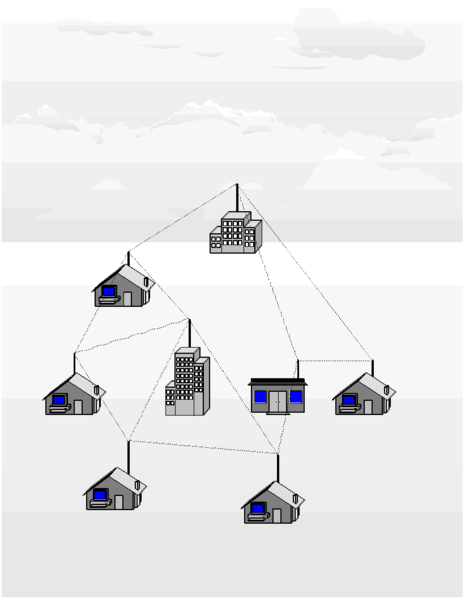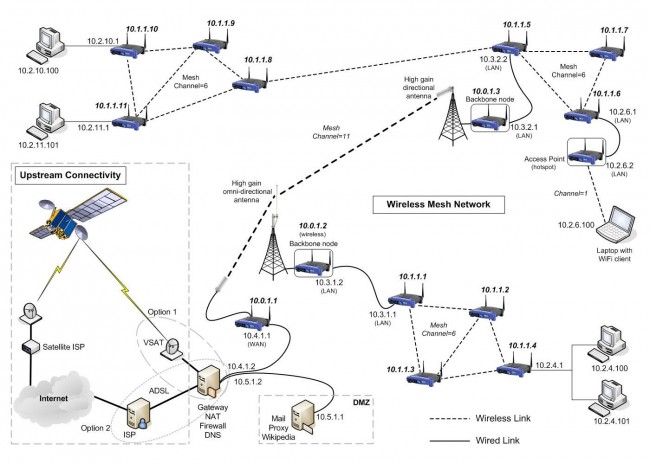Wireless IP Ethernet (802.11) technology has been around for a while. Many know it as “WIFI” but you could also call it “WLAN” or something similar. Like many other Ethernet technologies, WLAN relies on a spoke and hub connection system. The hub is the wireless access point or router and the individual hosts (PCs, tablets, phones, etc) are the end point for each connection. In a wired network, it is usually some type of switch that forms the center of the network data distribution system.
With a wireless mesh network or ad hoc network (802.11s), each wireless device can connect to any other wireless device within range. In this type of peer-to-peer network, there is no central access point, although something can act as an internet gateway or there can be several gateways. This type of topology functions much like the public network (AKA the internet), where there are many different paths to anyone (major) destination. If any one of those paths goes down, another route is quickly found.
This technology was developed by several vendors for military communications systems and for OLPC (One Laptop Per Child) programs in Africa and other places. Each link acts to extend the boundaries of the network, thus the more users there are, the more useful the network becomes.

Advantages of mesh networking:
- Networks are self-forming; once the nodes are configured and can see other network nodes, the network automatically forms
- Networks are self-healing; if one node drops offline, traffic is automatically routed to other nodes. If the node comes back up, it is included back into the network
- High fault tolerance; in areas where many nodes exist and can see each other, the failure of any single node does not affect the rest of the network
- Low cost to deploy; mesh networks use standard off-the-shelf WLAN (802.11) devices. The choice of software will dictate which hardware will work the best
- Crowd-sourced infrastructure; as each network node is owned by an individual, the cost and responsibility is shared among the community
Several specific routing protocols have been developed for the network side of the system. Hazy Sighted Link State Routing Protocol (HSLS), BATMAN, OLSR HWMP and others. These work well with the existing 802.11 a/b/g wireless network hardware currently available.
On the host side, a good IBSS-capable wireless network adapter is needed, which many of the newer ones are. Several of the software programs have lists of WLAN adapters that work with their software. Open Garden is a free App for Windows, Mac OSX, and Android, and they are working on an iOS version. This leaves out certain devices like tablets and iPhones for now.
Since existing wireless adapter drivers do not yet support mesh networking, usually an additional piece of software is needed. There are several interesting ones, including HSMM-MESH, which was developed by Amateur Radio operators. Open-source programs for Linux, Free BSD and other are available as well as commercial versions for Windows.
I was thinking that this might be useful for broadcast applications. For obvious reasons, this type of system would work best in densely populated urban and suburban areas, which is exactly the type of area in which LPFM licenses might be hard to come by. For those who do not have the time or wherewithal to apply for an LPFM license, or for those that simply don’t get a license due to scarcity of available channels, this could be a great way to cover a neighborhood or section of a city. The more people participate in the mesh network, the stronger the network becomes. Additionally, by using FCC type accepted part 15 FM and AM transmitters as broadcast nodes, carrier current transmitters, and leaky coax systems, the presence of the mesh network can be advertized to potential listeners, including directions on how to take part.

Wireless LAN bridges or broadband internet connections can act as a backbone between distant nodes.
For bandwidth efficiency sake, AOIP services should be limited to multicast addresses.
A good site with more wireless mesh network information is http://wirelessafrica.meraka.org.za/
Two subreddits on the subject: /r/meshnet and /r/darknetplan
Then there is project meshnet and the project meshnet wiki
Oh, by the way, go ahead and ask me what I have been learning about in school these days…
